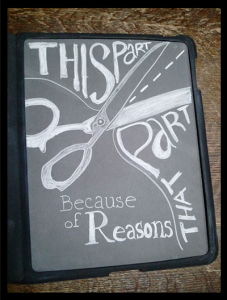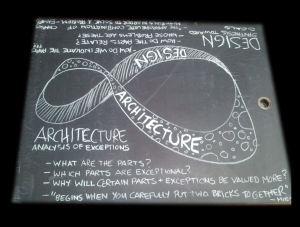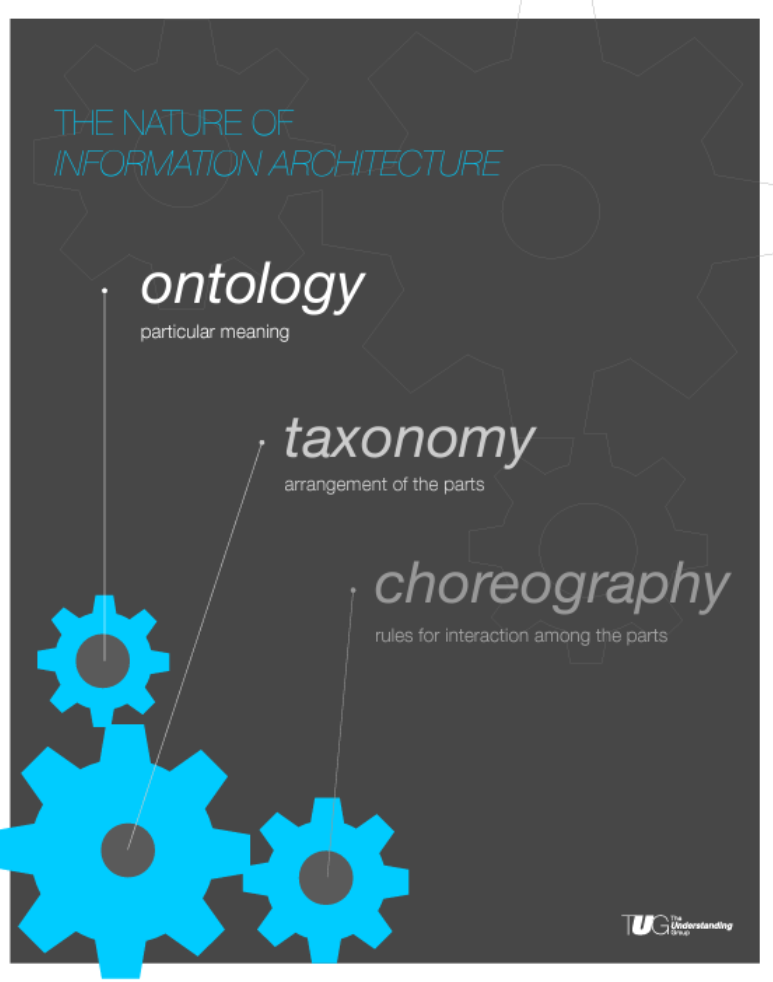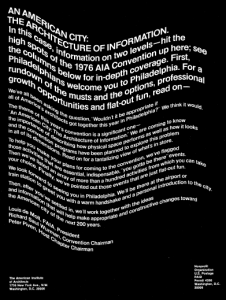A Model for Understanding Information Architecture: Ontology, Taxonomy and Choreography
An excerpt from a workshop I gave at The Understanding Group in Ann Arbor on March 7, 2013.
Keynote for AIA Michigan Annual Meeting
Re-introducing: The Architecture of Information
An idea that failed to become a Big Deal in the AIA in 1976, its roots in the workshop of Louis Kahn, and why it matters now more than ever.
Video I captured from the podium (audio is a little iffy)
In 1977, Richard Saul Wurman shuttered his failing architecture practice and moved to Los Angeles. By the mid 80s, he’d invented the TED conference series, redesigned the PacBell Yellow Pages and was publisher of a revolutionary series of travel guidebooks. These innovation were based quite specifically on the concepts he learned from Lou Kahn in the 1960s and which he introduced as “information architecture” as chairman of the AIA national meeting in 1976.
In 60 richly-illustrated minutes, Wurman scholar and practicing information architect Dan Klyn shares the story of the 1976 AIA national meeting, the invention of information architecture, and the ways that the work of Wurman and fellow Kahnian Robert Venturi continue to demonstrate the extraordinary power of architecture to create and shape the meaning of place and space.
Lou Kahn: Architects Not Designers
As quoted in Brownlee and De Long, Louis I Kahn, 177.

The Fisher House, Lou Kahn
I think architects should be composers and not designers. They should be composers of elements. The elements are things that are entities in themselves”
Architecture ≠ Design
Architecture and design are not the same thing. It’s been my cause célèbre of late, perhaps to a fault. This differentiation and its impact on how we might go about doing information architecture work is part of a talk I’ve been giving called “Establishing What ‘Good’ Means.” It’s also been featured in a blog posting for TUG, the information architecture consulting practice I co-founded last year. The lot of it is inspired by a brilliant lecture by Peter Eisenman entitled Architecture or Design: Wither the Discipline. A preposterously curt paraphrase of that lecture is as follows:
Architecture is not design: it’s a different discourse. Architecture is an analytical process of identifying exceptions. Design is a synthetic process for solving problems.
Maybe it’s just me, but I think that the dias at the front of a lecture hall lends itself especially well to the rhetorical device of the sweeping generalization. Particularly when the words used in generalizing aren’t projected on screen behind the lecturer as the rhetorical blanket is being spread across the room. Mr. Eisenman is seated during this lecture and appears to be reading from written notes – no slides – so instead of watching the video I just listened to the words and let my imagination develop whatever images it liked. The picture that developed in my mind’s eye as Eisenman delineated between architecture and design was that of a great expanse of cloth. And as I considered the image of the expanse of cloth, its aptness as a metaphor for differentiating between architecture and design convicted me.
Think of a big project you worked on last week. That project in its entirety is the great expanse of cloth. Architecture is where the cuts go; defining what the parts of the project are and how they’ll inter-relate. Architects operate the scissors. Designers work with the resulting parts and shape each part to be the best part it can be, solving the problems defined in the act of saying and then indicating in an incisive way “this part is not that part.”
 Architecture happens, to misuse Mies, because of reasons. In his words it begins “with the careful placement of two bricks,” and continues, in my reading of Eisenman, through an analytical process whereby the available permutations with those two bricks are explored before an ideal system for placement is developed.
Architecture happens, to misuse Mies, because of reasons. In his words it begins “with the careful placement of two bricks,” and continues, in my reading of Eisenman, through an analytical process whereby the available permutations with those two bricks are explored before an ideal system for placement is developed.
Design begins, for Eisenman at least, after the matter of the placement(s) of the bricks has been settled. After, in the terms of the metaphor of the cloth, the cuts have been made.
Oftentimes, the synthetic process of making a part be the best part it can be will reveal an exception that the architect missed. The problem one was given to solve with design turns out to be impervious to the workings of the designer because the architecture is wrong. Back to the metaphor of the fabric, it is to be expected and appreciated that designers will sometimes find their piece of the overall fabric of the project needs to be sewn back into its formerly-adjoining pieces and then re-cut. In this way, the relationship between design and architecture is less a binary zero-sum game than it is a mobius strip:

Your project is a piece of cloth. Architecture is where the cuts go; architects hold the scissors.
Design is making the resulting parts be the best parts they can be, solving the problems defined in the act of cutting.
User Experience Design and Information Architecture – Centered and Bounded Sets
The centered set approach is like gathering cats rather than herding cattle. The center is the pail of milk that draws the cats.
This morning I finally checked Phyllis Tickle’s The Great Emergence off of my reading list. I consumed it in one sitting, learned a ton, and regretted not having read it sooner. If you’re unfamiliar with Tickle, she’s the founding religion editor at Publishers Weekly, where she perfected a manner of explaining what religious people think and talk about for a business audience.
Toward the end of the book, she explains a bit about the work of a Quaker theologian named John Wimber, and his way of describing a particular dialectic within Christianity in terms of centered sets and bounded sets.
Bounded Sets
Bounded sets are defined by rules and definitions. Authority is in the definitions. You’re a member of the set if you adhere to the rules and fit the definitions, and if you’re not – you’re not.
Centered Sets
Contrarily, a centered set is one where authority is centered wherever the critical mass of participants are located. Membership in the set is not a function of definitions or boundaries, but is rather a function of trajectory. If you’re facing and heading toward the center, you’re in, regardless of how close to the center you may now be. And even while you may have been face-deep in the proverbial pail, once you turn away from the center you’re not in the set anymore.
Which Way To Catopolis?
I wish I had been fluent in the ways of this dialectic in 2009 when I attended the IA Summit in Memphis. At the time I was flabbergasted by Jesse James Garrett’s closing plenary, but equipped with the framework of centered and bounded sets, I think I might have had a better shot at understanding what Mr. Garrett was doing in his talk.
As long as you have information architects, what they do will always be information architecture. Seems pretty obvious, right? Only took me seven years to figure out.
But that’s okay, because what is clear to me now is that there is no such thing as an information architect… there’s no such thing as an interaction designer either. There are no information architects. There are no interaction designers. There are only, and only ever have been, user experience designers.
– Jesse James Garrett, Closing Plenary at IA Summit 2009
I hesitate to make blanket generalizations about the 352 practitioners who were present for JJG’s fusillade in that peculiar ballroom at the Peabody Hotel. But is it fair to say we were a microcosm of the larger, global community of IA and UX and IxD and UCD practice numbering in the thousands? I think that’s a fair statement.
And I think what JJG knew when he stalked up and down the center aisle of that ballroom was that a bounded set defined as information architecture would contain quite less than a majority of the “cats” in the community of practice represented by the people in that room. And that even if one were to re-name the bounded set as IxD, that still does not make one the mayor of Cat Town. Cat Village, perhaps, but not Catopolis. No, to be mayor of Cat Town, you have to be where the pail is. What Jesse knew then and what is likely still true today is that a centered set analysis shows quite clearly where the pail is, and what’s in it.
What’s in the Pail?
I think a centered set analysis of the activities, interests and affinities of the wide community of practice – back in the ‘oughts and still today – shows that user-centricity is the place where most of the cats are, and the pail is full of design.
The Centered Set Called User Experience Design
The pail is design, and it’s situated in a place where users and their experiences are the center of gravity. Do you start from a place of user centricity? Are you involved in problem solving? Is your work about synthesis, and about making users’ experiences better and goals more easily attained? Excellent! You belong to the set. Figuring out matters of identity and belonging are easy, and a wide cohort is guaranteed when all you’re talking about is trajectory.
When Mr. Garrett said “there are only user experience designers,” what he was saying was mostly true from a centered-set analysis standpoint. Indeed, the only way to fall out of this centered set called UXD is to not be on a trajectory that’s primarily about users’ needs and experiences, and/or to reject design as the center of the thing that’s bringing all of us cats together.
Broken Bounds
Back in the 2000s, a bounded set called Information Architecture was attempted by this community, and it didn’t work. The boundary to differentiate the herd of would-be IA cats from other bounded sets like HCI and IxD was poorly defined (everybody more or less works on “the structural design of shared information environments”), and the ensuing frustration about definitions, and about who was “in” and who was “out” made a wholesale shift to the other pole of the dialectic inevitable. Inevitable is a strong word, but in a community of practice where the most off-limits, taboo conversation is a conversation about the definition of information architecture, I think “inevitable” is appropriate.
Thank heavens Mr. Garrett was there to kick the last rickety crutch out from under the bounded set that used to be called Information Architecture. Immanentizing the IA eschaton, as it were. Jesse gambled a king’s ransom in social capital in that act of benevolent destruction and single-handedly (literal iPhone pun here) reframed the collective identity of the community of practice.
What had been called IA was a narrow and fussy bounded set that was hard to work the boundaries of, and what opened up after Memphis is a wide and accommodating centered set whose trajectory and center of gravity align both with how members of the community go about their work and also with what the market seems to want and need. If one had a dollar for every tweet about how Design and UX are a hot thing in the C-suite since Jesse’s talk in 2009, one could – as the kids say – make it rain.
Jesse did a great thing there in Memphis. Using his considerable gifts of persuasion, oration and gothy gravitas, he compelled a sea change in our community of practice. Where there had once been a poorly-bounded set around something called Information Architecture (always rendered metaphorically and therefore with the initial capital letters), there is now a well-centered one called UX. Cats around a pail, not climbing over and around a fenced-off box.
Toward A (re)Bounded Set Called Information Architecture?
The ease and fluency with which designers and clients alike can move into and around the centered set of practices and concepts of UXD brings with it a marvelous opportunity to re-define a bounded set for the remnant of cats for whom the bucket of design is interesting but not the central thing drawing one in, and for which the place of beginning isn’t end users and designing their experiences.
More on that in the coming weeks.
Note: the quote at the top of this entry is borrowed from the Vineyard Church of Ann Arbor’s website
The Umbrella of UX
There was an interesting question posted to the IxDA mailing list yesterday:
Can we say that Usability, User centered design,
Information Architecture and interaction design fall under the umbrella
of User experience design?
I offered a perspective on Rohit’s question. Wonder how this’ll land.
Hi Rohit,
What follows is pretty parsimonious, but I suppose that’s what email lists are for?
There are some folks who use Use Experience as their umbrella construct or philosophical approach to the making of communications systems and artifacts. For these folks, “doing the information architecture” is a project phase or part of a project phase, one that is sometimes blended with “doing the interaction design.” And all of it is done with the experience of the user as the drum major at the front of the parade, and experience as the explicit designed-for outcome. Their business card says whatever it needs to say – they’re not hung up on titles, but instead are passionate about users and about how to make stuff that’s awesome by prizing experience in the design and development process.
There are also some folks who are called User Experience Designers, who see User Experience Design (capital D) as the name for the umbrella and as their preferred name for the nascent field of practice. Many of these folks used to be or would have been called IA or IxD in a similar job 5 years ago. They use UXD instead of IA or IxD because that’s what we call it now, and see the other initials as more or less interchangeable but less advantageous in conversation, publishing, tribal identity etc.
More exotically, there are some folks who (still) use Information Architecture as their umbrella construct or philosophical approach to the making of communications systems and artifacts. For these folks, the work is about understanding, and the philosophy is that understanding precedes action. Their work is akin to the work of other architects, only the structures they create are made of information. In shaping the forms that comprise the structures of an information architecture, they’re balancing and aligning business priorities, user priorities, aesthetic implications, matters of choreography… And all of it is done with Understanding as the drum major at the front of the parade, and performance as the explicit designed-for outcome. Their business card says whatever it needs to say – they’re not hung up on titles (ok, some of them are), but instead are passionate about the “what” of their projects and about how to ensure the stuff they work on is awesome by providing structures of language and information which enshrine the “what” of the project or enterprise in ways that designers and developers can then work within as they come up with the “how”‘s of the project.
Best wishes,
Dan K
Logo Studies for The Understanding Group
Note, this post has moved to TUG’s blog: MakingThingsBe.Gd.
Repost: 2009 Conversation with Richard Saul Wurman
Recordings of my first telephone conversation with Richard Saul Wurman:
- Part One
- Part Two (Repost Coming Soon)
- Part Three
- Part Four
Giving A Talk at Lansing IxDA Chapter Kickoff
Update: Proud to announce that Michigan’s own Dan Klyn (@danklyn) will be our new guest speaker Sept 16. Don’t miss it! http://bit.ly/bZLJqG




